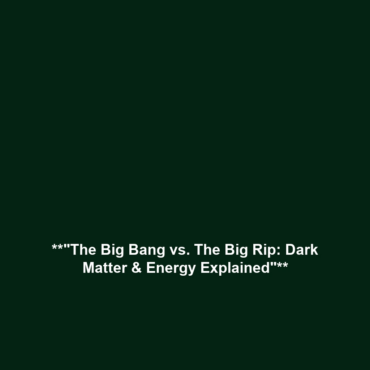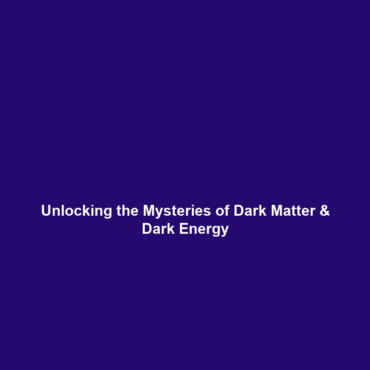The Big Bang vs. The Big Rip: Competing Theories in Dark Matter & Dark Energy
Introduction
The exploration of The Big Bang vs. The Big Rip: Competing Theories is crucial for understanding the universe’s fate and the fundamental characteristics of dark matter and dark energy. The Big Bang theory, positing an explosive origin to our universe, contrasts sharply with the Big Rip scenario, which suggests an eventual disintegration of the cosmos. These theories are significant as they challenge existing paradigms and expand our comprehension of dark energy’s role in the universe’s expansion. This article delves into the major concepts, applications, challenges, and future research regarding these two prominent cosmological theories.
Key Concepts
The Big Bang Theory
The Big Bang theory is the prevailing cosmological model explaining the universe’s expansion from an extremely hot and dense initial state. Key features include:
- Cosmic Microwave Background Radiation
- Expansion of the universe as observed through redshift
- Formation of the elements during nucleosynthesis
This theory serves as the foundation for understanding dark matter’s pervasive yet elusive presence in the universe.
The Big Rip Theory
In contrast, the Big Rip hypothesizes that if dark energy’s repulsive force increases indefinitely, it could lead to the ultimate destruction of all structures in the universe, encompassing galaxies, stars, and even atomic particles. Major implications include:
- Endless acceleration of the universe’s expansion
- Potential breakdown of physical laws as we know them
These hypotheses prompt significant discussion within the domain of dark matter and dark energy, as they interplay in governing the universe’s fate.
Applications and Real-World Uses
The frameworks of The Big Bang vs. The Big Rip: Competing Theories influence various fields of research, including cosmology, astrophysics, and theoretical physics. Significant applications include:
- How the Big Bang is Used in Dark Energy Studies: Understanding the universe’s age and dynamics helps scientists develop models predicting future expansions and assess the behavior of dark energy.
- Applications of the Big Rip in Theoretical Physics: The Big Rip scenario serves as a theoretical foundation for potential models that explore the implications of dark energy exceeding critical thresholds.
Current Challenges
Despite the contributions of these theories to our understanding of dark matter and dark energy, several challenges persist:
- Challenges of Empirical Validation: Limited observational evidence makes validating the Big Rip scenario inherently difficult.
- Issues in Dark Matter Detection: Current technologies struggle to detect dark matter particles directly, complicating theories reliant on their properties.
- Complexity of Dark Energy: The true nature and behavior of dark energy remain one of the largest unsolved mysteries in cosmology.
Future Research and Innovations
Research continues to evolve concerning both the Big Bang and the Big Rip, with promising innovations on the horizon:
- Development of next-generation telescopes aimed at capturing more profound cosmic phenomena.
- Innovative simulations to model scenarios regarding dark energy and its effects based on the Big Rip hypothesis.
- Advanced theoretical frameworks that may offer new insights into dark matter properties and behaviors.
Such breakthroughs could significantly enhance our grasp of the universe’s ultimate destiny.
Conclusion
In summary, the exploration of The Big Bang vs. The Big Rip: Competing Theories plays a pivotal role within the study of dark matter and dark energy. As researchers uncover more about these profound cosmological theories, understanding their implications reshapes our perception of the cosmos. For further reading, interested individuals can explore related topics such as Dark Energy and Future of Cosmology to deepen their knowledge.

